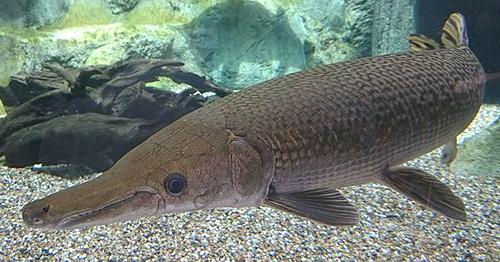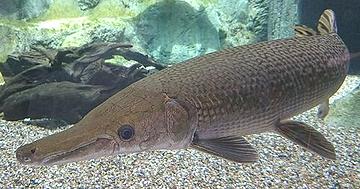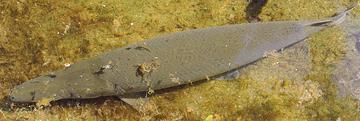 [Family Lepisosteidae]
[Family Lepisosteidae]
These fish are considered "living fossils", as they have been around for over 100 million years, and have retained many primitive features. There are now 7 surviving species in two genera, and all but one are listed IUCN LC (Least Concern) - clearly a successful family of fish. All are fresh water fish that sometimes enter brackish waters but rarely wander into the salt sea. All Gars are native to North and Central America and the Caribbean region. These fish are totally unrelated to the European Garfish.
Gars don't have the overlapping scales of modern fish, their "Ganoid Scales" are interlocking plates of enamel coated bone, pretty much inpenytrable to predators. They themselves are fierce predators, usually by ambush, and have very toothy jaws. Like some other primitive fish, they can breath air.
All the Gars are considered edible, but their eggs are extremely toxic to humans. Photo by ProjectManhattan distributed under license Creative Commons Attribution-ShareAlike v4.0 International.
More on Varieties of Fish
(very large page).
 [Atractosteus spatula]
[Atractosteus spatula]
The largest of the Gars, this one can grow to 10 feet (3 meters) and 350
pounds (160 kg). This fish is found in the river drainages as far north as
Ohio, as far east as the Florida Panhandle, and along the Gulf of Mexico
a small way into Mexico. Generally, it is caught wild, but is of interest
for aquaculture as it is tolerant of water conditions, fast growing, disease
resistant, and has a high meat yield. It is sold as meat in the Mississippi
drainage region. IUCN Red List LC (Least Concern).
 [Atractosteus tristoechus]
[Atractosteus tristoechus]
The Second largest of the Gars, this one can grow to 6.6 feet (2 meters)
but are usually around 3.3 feet (1 meter). This fish is found only in lakes,
rivers and estuaries of Western Cuba and Isla de la Juventud, just south
of Cuba. It is subject to subsistence fisheries and IUCN Red List CR
(Critically Endangered). Aquaculture is in the experimental stages and
restocking is planned, but neither is far advanced. Do not catch or eat
this fish.
Photo by Poleta33, distributed under license Creative Commons
Attribution-ShareAlike v3.0 Unported.
 [Atractosteus tropicus]
[Atractosteus tropicus]
This fish is found in lakes and rivers of both the Pacific and Gulf of Mexico drainages of southern Mexico and Central America. this one can grow to 49 inches (125 cm) and 6 pounds (2.9 kg), but are more commonly about 24 inches (60 cm).
Some references list the Tropical Gar as toxic to humans, but there is a
recipe from Tabasco, Mexico that requires them and cooks them with chili,
limes, and salt. Also I have seen mention that they are a significant food
source in Guatemala, and Nicaragua reported landing 87 tonnes in 2011. It
is certain, however, that their eggs, like those of all Gar, are highly toxic
to humans. IUCN Red List LC (Least Concern)
Photo by Castro C. from Fishbase, distributed under license
Creative Commons
Attribution v3.0 Unported.
 [Lepisosteus oculatus]
[Lepisosteus oculatus]
This Gar is native to lakes and rivers of North America
from southern Ontario to the Gulf of Mexico, and from western Texas to the
Florida Panhandle, with some isolated populations outside that area, including
one at the southern tip of Florida. They can grow to almost 5 feet long and
9.7 pounds (4.4 kg), but are more commonly about 3-1/4 feet (100 cm). They
are a commercial catch in the lower part of their range, but not in the
Great Lakes region where they are high in mercury and other unhealthy
substances from industrial pollution. IUCN Red List LC (Least Concern).
Photo by Usien, distributed under license Creative Commons
Attribution v3.0 Unported.
 [Lepisosteus osseus]
[Lepisosteus osseus]
This Gar has a wide range, from southern Quebec through the Great Lakes
region and the Mississippi and Missouri drainages to the Rio Grande river, and
from New Jersey to central Florida. They can grow to almost 6.6 feet long
(200 cm) and 50.3 pounds (22.8 kg), but are more commonly about 3-1/4 feet
(100 cm). To humans, they are primarily a sports fish, but some people
consider them to be a very good eating fish. IUCN Red List LC (Least Concern),
but are a concern in some states due to overfishing.
Photo by Cephas, distributed under license Creative Commons
Attribution-ShareAlike v3.0 Unported.
 [Lepisosteus platostomus]
[Lepisosteus platostomus]
This Gar is found in the Mississippi, Missouri and Ohio river drainages
south to the Gulf Coasts of Louisiana, Alabama, and a little into Texas. They
can grow to 2.9 feet long (88 cm) and 5.7 pounds (2.6 kg), but are more
commonly about 2 feet (61 cm). They are important to ecologies, but are not
much used as a food fish. IUCN Red List LC (Least Concern), but are a concern
in Montana and Ohio due to limited range.
Photo by AlejandroLinaresGarcia, distributed under license
Creative Commons
Attribution-ShareAlike v4.0 International.
 [Lepisosteus platyrhincus ]
[Lepisosteus platyrhincus ]
This Gar is found from the Savannah river, Georgia, down through peninsular
Florida. They can grow to
4.3 feet long (132 cm) and 21 pounds (9.6 kg), but are more commonly about
2 feet (61 cm). Although edible, they are not a popular food fish. Like all
Gars, their eggs are highly toxic to humans. IUCN Red List LC (Least Concern).
Photo by Raimond Spekking , distributed under license
Creative Commons
Attribution-ShareAlike v4.0 International, Attribution required.
.